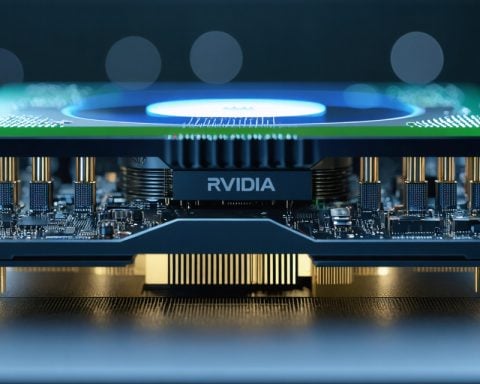- Microsoft introduces Majorana 1, a revolutionary chip aimed at making quantum computing practical for solving complex industrial challenges.
- Quantum computing is poised to redefine fields like medicine and chemistry by performing calculations beyond the reach of classic computers.
- Unlike traditional tech strategies, Microsoft explores topological states and Majorana particles, potentially sparking a tech revolution akin to semiconductors.
- The Majorana 1 chip starts with eight qubits, with plans to scale to millions, promising massive computational advancements.
- While the potential is vast, experts like Professor Paul Stevenson emphasize the significant obstacles yet to be overcome, advocating for cautious optimism.
- Microsoft envisions a transformative future where quantum computing breakthroughs drive new realms of innovation and discovery.
Gliding into the realm of particle physics and futuristic computing, Microsoft quietly flips the narrative on quantum supremacy. At the heart of this revelation lies Majorana 1, a groundbreaking chip designed to catapult quantum systems into the sphere of practicality, aiming to solve complex industrial problems at a pace once thought impossible.
Quantum computing, often hailed as the Holy Grail of technological advancement, challenges the status quo of classical computing. These advanced systems promise to unravel puzzles in medicine, chemistry, and beyond, given their capability to process calculations that would leave today’s top-tier computers gasping for breath.
Microsoft’s innovative stride bypasses conventional avenues pursued by tech giants. In a daring move, the tech conglomerate strides forward with a “high-risk, high-reward” approach, venturing into the mysterious domain of topological states — neither gas, liquid, nor solid — and the elusive Majorana particles. This marks a potential turning point analogous to the semiconductor revolution that transformed computing as we know it.
Despite having only eight qubits on its initial chip—fewer than competitors—Microsoft hints at scaling these to millions, promising a quantum leap in computational might. This optimism, however, comes tempered by the voices of the scientific community. Pioneers like Professor Paul Stevenson acknowledge the formidable hurdles remaining, urging cautious optimism while spotlighting the promise held by Microsoft’s new strategy.
As the dust settles on Majorana 1’s unveiling, the tech world stands at a precipice. Microsoft invites us to envision a near future where quantum computers reshape not just technology, but the very fabric of innovation. As the company boldly claims, its topoconductors might just be the key to unlocking a new era of discoveries and solutions.
Is Microsoft’s Majorana 1 the Key to Quantum Supremacy?
Features, Specs & Pricing
Microsoft’s Majorana 1 chip represents a significant stride in quantum computing. Unlike regular chips that operate using traditional transistors, Majorana 1 utilizes Majorana particles—exotic quasiparticles that may enable error-resistant quantum computing. Despite hosting only eight qubits initially, Microsoft plans to scale to millions. However, their exact architecture, specifications, and pricing have not been publicly disclosed, as the technology is still experimental.
Real-World Use Cases
Quantum computers, including those employing chips like Majorana 1, could revolutionize industries by solving complex problems currently intractable for classical computers. Areas of potential impact include:
– Medicine: Accelerating drug discovery by simulating molecular interactions with unparalleled precision.
– Chemistry: Solving complex chemical reactions that are beyond the capabilities of current classical computing methods, potentially leading to new materials and energy solutions.
– Cryptography: Developing more secure encryption methods, while also posing a threat to current encryption systems.
– Logistics & Optimization: Streamlining large-scale logistical operations and enhancing machine learning models.
Market Forecasts & Industry Trends
The quantum computing market is expected to grow substantially, potentially reaching a valuation of $65 billion by 2030, according to some industry reports. Investment is soaring, with tech giants like Google and IBM competing alongside Microsoft to achieve quantum supremacy. Expect significant advancements in the interoperability of classical and quantum computing systems over the next decade.
Reviews & Comparisons
While Microsoft’s approach differs by leveraging topological quantum computing, other companies like Google and IBM focus on different architectures, such as superconducting qubits. It’s unclear which technology will prevail, but Microsoft’s strategy is noted as a high-risk, high-reward path. Early reviews from the scientific community urge cautious enthusiasm, acknowledging technological hurdles yet to be overcome.
Controversies & Limitations
Quantum computing, and Microsoft’s role within it, raises questions about ethical implications, such as the future of encryption and cybersecurity. Moreover, practical limitations include maintaining qubit coherence and error rates, which currently constrain the scalability and functionality of quantum systems.
Security & Sustainability
Security is a double-edged sword in quantum computing. While offering breakthroughs in secure communications, the technology also threatens current encryption standards. Sustainability, meanwhile, remains a challenge, as the high energy requirements of cooling quantum systems are an environmental concern yet to be resolved.
Insights & Predictions
Microsoft’s dive into quantum computing could democratize access to high-performance computing, altering fields like AI, machine learning, and more. As practical quantum computers become more viable, we’ll likely see a paradigm shift akin to the impact of the semiconductor revolution.
Tutorials & Compatibility
There is limited hands-on material available for the Majorana 1 at this stage, but interested developers can look forward to emerging content as quantum technologies advance. Microsoft’s Quantum Development Kit provides resources for those keen to explore.
Pros & Cons Overview
Pros:
– Potential breakthrough in quantum error correction.
– Scalable solution towards larger, more powerful quantum systems.
– Opens up new avenues for high-impact industry solutions.
Cons:
– Technology is in its nascent stage with significant technical hurdles.
– High cost and energy requirements pose sustainability concerns.
– Ethical and security implications are yet to be fully understood.
Actionable Recommendations
1. Stay Informed: Regularly follow updates from credible sources like academic journals or reputable tech news outlets to stay abreast of quantum computing developments.
2. Skill-Up: Develop skills in quantum computing through online courses and Microsoft’s Quantum Development Kit for future-proofing your tech career.
3. Join the Conversation: Participate in forums and webinars on quantum technologies to discuss and explore this rapidly evolving field.
For more information, you can visit Microsoft’s official website: Microsoft.
By keeping a close watch on these developments, businesses and individuals alike can prepare to leverage the transformative potential of quantum computing in the near future.













